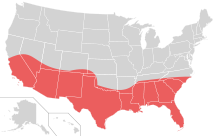
Back الحزام الشمسي للولايات المتحدة الأمريكية Arabic Cinturón del Sol AST Sun Belt German Ζώνη του Ήλιου Greek Suna Zono Esperanto Cinturón del Sol Spanish Eguzkiaren gerrikoa Basque کمربند آفتاب Persian Sun Belt French Sun Belt Croatian
Parts of this article (those related to COVID-19) need to be updated. (November 2023) |

The Sun Belt is a region of the United States generally considered stretching across the Southeast and Southwest. Another rough definition of the region is the area south of the Parallel 36°30′ north.[1] Several climates can be found in the region—desert/semi-desert (Eastern California, Nevada, Arizona, New Mexico, Utah, and West Texas), Mediterranean (California), humid subtropical (Alabama, Mississippi, Louisiana, Florida, Georgia, South Carolina, North Carolina, Tennessee and Texas), and tropical (South Florida).
The Sun Belt has seen substantial population growth post-World War II from an influx of people seeking a warm and sunny climate, a surge in retiring baby boomers, and growing economic opportunities. The advent of air conditioning created more comfortable summer conditions and allowed more manufacturing and industry to locate in the Sun Belt. Since much of the construction in the Sun Belt is new or recent, housing styles and design are often modern and open. Recreational opportunities in the Sun Belt are often not tied strictly to one season, and many tourist and resort cities in the region support a tourist industry all year.[2][3][4]
- ^ "Large, young and fast-growing Sun Belt metros need urban policy innovation | Kinder Institute for Urban Research".
- ^ Kaid Benfield. "Where Pittsburgh Has the Sun Belt Beat". CityLab.
- ^ Woods, Michael (January 18, 1981). "Desert-Like Conditions Hurt Sun Belt". The Blade (Toledo, OH)., reprinted by Google News Archive
- ^ Wichner, David (September 6, 2022). "Tucson region led Arizona tourism spending rebound in 2021". Arizona Daily Star., [1]